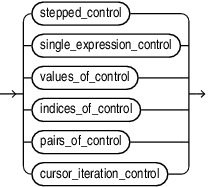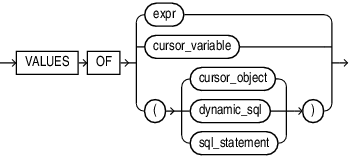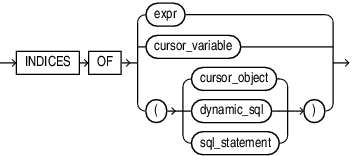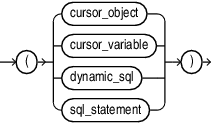14.43 Iterator
The iterator specifies an iterand and the iteration controls.
Syntax
iterator ::=
iterand_decl ::=
iteration_ctl_seq ::=
qual_iteration_ctl ::=
iteration_control ::=
( stepped_control ::=, single_expression_control ::= , values_of_control ::=, indices_of_control ::=, pairs_of_control ::=, cursor_iteration_control ::=)
pred_clause_seq ::=
stepped_control ::=
single_expression_control ::=
values_of_control ::=
cursor_iteration_control ::=
dynamic_sql ::=
Semantics
iterator
The iterator specifies an iterand and the iteration controls.
Statements outside the loop cannot reference iterator. Statements inside the loop can reference iterator, but cannot change its value. After the FOR LOOP statement runs, iterator is undefined.
iterand_decl
An iterand type can be implicitly or explicitly declared. You cannot explicitly initialize an iterand.
Table 14-1 Iterand Implicit Type Defaults
| Iteration Control | Implicit Iterand Type |
|---|---|
| stepped control | PLS_INTEGER |
| single expression | PLS_INTEGER |
| cursor control | CURSOR%ROWTYPE |
VALUES OF control
|
collection element type |
INDICES OF control
|
collection index type |
PAIRS OF control
|
The first iterand denotes the index type of collection and the second iterand denotes the element type of collection |
pls_identifier
The iterand name for the implicitly declared variable that is local to the FOR LOOP statement.
[ MUTABLE | IMMUTABLE ]
The mutability property of an iterand determines whether or not it can be assigned in the loop body. If all iteration controls specified in an iterator are cursor controls, the iterand is mutable by default. Otherwise, the iterand is immutable. The default mutability property of an iterand can be changed in the iterand declaration by specifying the MUTABLE or IMMUTABLE keyword after the iterand variable. The mutability property keywords are not reserved and could be used as type names. Such usage would be ambiguous. Therefore, you must explicitly specify the mutability property of an iterand in the iterand declaration if its type is named mutable or immutable. Iterand for INDICES OF iteration control and the index iterand for PAIRS OF iteration control cannot be made mutable.
constrained_type
An iterand is explicitly declared when the iterand type is specified in the loop header. Any constraint defined for a type is considered when assigning values to the iterand. The values generated by the iteration controls must be assignment compatible with the iterand type. Usual conversion rules apply. Exceptions are raised for all constraint violations.
iteration_ctl_seq
Multiple iteration controls may be chained together by separating them with commas.
Restriction on iteration_ctl_seq:
Because two iterands are required for the pairs of iterand, pairs of iteration controls may not be mixed with other kinds of iteration controls.qual_iteration_ctl
The qualified iteration control specifies the REVERSE option and the optional stopping and skipping predicates clauses.[ REVERSE ]
When the optional keyword REVERSE is specified, the order of values in the sequence is reversed.
You can use this option with a collection vector value expression. In that case, specifying REVERSE generates values from LAST to FIRST rather than from FIRST to LAST.
REVERSE:
- You cannot use this option when a pipelined function is specified in the iteration control.
-
You cannot use this option with single expression iteration control since it generates a single value and therefore the keyword does not have any sensible meaning for this control.
-
You cannot use this option when the iteration control specifies a SQL statement. This creates a sequence of records returned by the query. You can specify an
ORDER BYclause on the SQL statement to sort the rows in the appropriate order. - You cannot use this option when the collection is a cursor,cursor variable, dynamic SQL, or is an expression that calls a pipelined table function.
iteration_control
An iteration control provides a sequence of values to the iterand.
pred_clause_seq
An iteration control may be modified with an optional stopping predicate clause followed by an optional skipping predicate clause. The expressions in the predicates must have a BOOLEAN type.
[ WHILE boolean_expression ]
A stopping predicate clause can cause the iteration control to be exhausted. The boolean_expression is evaluated at the beginning of each iteration of the loop. If it fails to evaluate to TRUE, the iteration control is exhausted.
[ WHEN boolean_expression ]
A skipping predicate clause can cause the loop body to be skipped for some values. The boolean_expression is evaluated. If it fails to evaluate to TRUE, the iteration control skips to the next value.
stepped_control
lower_bound .. upper_bound [ BY step ]
Without REVERSE, the value of iterand starts at lower_bound and increases by step with each iteration of the loop until it reaches upper_bound.
With REVERSE, the value of iterand starts at upper_bound and decreases by step with each iteration of the loop until it reaches lower_bound. If upper_bound is less than lower_bound, then the statements never run.
The default value for step is one if this optional BY clause is not specified.
lower_bound and upper_bound must evaluate to numbers (either numeric literals, numeric variables, or numeric expressions). If a bound does not have a numeric value, then PL/SQL raises the predefined exception VALUE_ERROR. PL/SQL evaluates lower_bound and upper_bound once, when the FOR LOOP statement is entered, and stores them as temporary PLS_INTEGER values, rounding them to the nearest integer if necessary.
If lower_bound equals upper_bound, the statements run only once.
The step value must be greater than zero.
single_expression_control
A single expression iteration control generates a single value. If REPEAT is specified, the expression will be evaluated repeatedly generating a sequence of values until a stopping clause causes the iteration control to be exhausted.
Restrictions on single_expression_control:
REVERSE is not allowed for a single expression iteration control.
values_of_control
The element type of a collection must be assignment compatible with the iterand.
indices_of_control
The index type of a collection must be assignment compatible with the iterand.
The iterand used with an INDICES OF iteration control cannot be mutable.
pairs_of_control
The PAIRS OF iteration control requires two iterands. You cannot mix the PAIRS OF iteration control with other kinds of controls. The first iterand is the index iterand and the second is the value iterand. Each iterand may be followed by an explicit type.
The element type of the collection must be assignment compatible with the value iterand. The index type of the collection must be assignment compatible with the index iterand.
The index iterand used with a PAIRS OF iteration control cannot be mutable.
cursor_iteration_control
Cursor iteration controls generate the sequence of records returned by an explicit or implicit cursor. The cursor definition is the controlling expression.
Restrictions on cursor_iteration_control:
You cannot use REVERSE with a cursor iteration control.
cursor_object
A cursor_object is an explicit PL/SQL cursor object.
sql_statement
A sql_statement is an implicit PL/SQL cursor object created for a SQL statement specified directly in the iteration control.
cursor_variable
Name of a previously declared variable of a REF CURSOR object.
dynamic_sql
EXECUTE IMMEDIATE dynamic_sql_stmt [ USING [ IN ] (bind_argument [,] )+]
You can use a dynamic query in place of an implicit cursor definition in a cursor or collection iteration control. Such a construct cannot provide a default type; if it is used as the first iteration control, an explicit type must be specified for the iterand, or for the value iterand for a pairs of control.
The optional USING clause is the only clause allowed with the dynamic SQL. It can only possibly have IN one or more bind variable, each separated by a comma.
dynamic_sql_stmt
String literal, string variable, or string expression that represents a SQL statement. Its type must be either CHAR, VARCHAR2, or CLOB.
Caution:
When using dynamic SQL, beware of SQL injection, a security risk. For more information about SQL injection, see "SQL Injection".
Examples
- Example 5-25, "Using Dynamic SQL as an Iteration Control"
- Example 5-17, "Stepped Range Iteration Controls"
- Example 5-18, "STEP Clause in FOR LOOP Statement"
- Example 5-24, "Cursor Iteration Controls"
- Example 5-21, "VALUES OF Iteration Control"
- Example 5-22, "INDICES OF Iteration Control"
- Example 5-23, "PAIRS OF Iteration Control"
Related Topics











